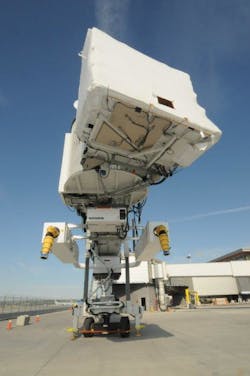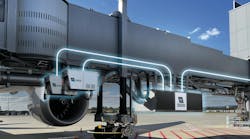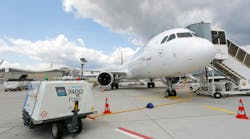Preconditioned air (PCA) units provide comfort to passengers while an aircraft is at the gate. However, a PCA cannot do its job effectively if the hose connecting the unit to the plane is damaged, kinked or not used properly.
The Boom Air Hose Management System, patented and manufactured by Twist Inc., reduces damage to PCA hoses by delivering the amount of hose necessary to reach the aircraft – without excess hose lying on the ramp.
“Twist was approached by a Delta pilot, attempting to solve the persistent problems with traditional hoses that deliver preconditioned air to the aircraft,” Twist’s Kali Ables explains, noting excess hose lying on the tarmac may have restricted airflow, prompting pilots to run the APU and burn fuel unnecessarily.
To combat the problem, Twist created the Boom Air in 2007.
The Boom Air unit is a stand-alone product, which can easily connect to existing PCAs via insulated ducting. It can be mounted on the bridge or on a mobile PCA unit. It can also be stand mounted.
Three models are available, accommodating hose lengths from 40 feet up to 135 feet.
The BAH135 is the largest model, consisting of a 16-foot cabinet that holds 135 feet of hose. The BAH080 offers a 13-foot cabinet with a capacity for 80 feet of hose, and the BAH040 has an 8-foot cabinet to hold 40 feet of hose.
“The 135-foot PCA hose is completely contained within the Boom Air cabinet,” Ables says. “When ready to connect to the aircraft, the operator simply selects the ‘deploy’ button on the remote control, walks the connector out to the aircraft, makes the connection and selects ‘PCA mode’ on the remote to begin air delivery.
“When finished, the hose is disconnected and the operator selects ‘retract’ on the remote control,” she continues. “The hose is then pulled back into the Boom Air cabinet, unassisted.”
Enclosed gears and a single-drive belt system provide synchronized hose deployment and retraction.
Because the Boom Air allows the hose to make a straight connection to the aircraft, it eliminates hose kinks and restriction.
“The Boom Air services the correct airflow and temperature to the aircraft, properly utilizing preconditioned air equipment,” says Ables.
What’s more, the stainless steel cabinet is heated for optimal hose temperature in cold climates.
The remote controlled hose deployment and retraction reduces stress placed on ground handlers, who otherwise may have to manually roll out hose sections weighing more than 100 pounds.
Additional features of the unit include PLC (programmable logic controllers) operation and minimal maintenance. Optional features include a hose configuration to include a zipper section; building management system integration; and installation of equipment.
“One of the best Boom Air selling features is that a single unit can service any aircraft manufactured to date,” Ables points out, adding Twist is currently the only hose management system that can achieve this.
A number of Boom Air units were put into service by American Airlines at Dallas/Fort Worth Airport and the Montreal Airport Authority, providing the company with operational feedback.
“The feedback from our customers led to numerous updates to accommodate airport ramp conditions and improve product reliability,” Ables says.
The Boom Air, which is a fully UL listed product, provides safety benefits through a number of built in features like hose position recognition; door interlocks and bridge interlocks. There are also environmental benefits.
“Through the FAA, the Boom Air qualifies for VALE (Voluntary Airport Low Emissions) funding when purchased with a new PCA unit,” Ables notes. “We have worked on many successful VALE projects, supplying Boom Air and PCAs.”
Currently, more than 300 units are in service, operating in the United States, Canada and Europe.
“American Airlines did a study that proved the ROI (return on investment) for the Boom Air (due to jet fuel savings) is approximately nine months,” Ables says. “Air Canada has recognized the need for Boom Air on all gates due to PCA utilization, worker’s safety and ease of snow removal around the gate.”




